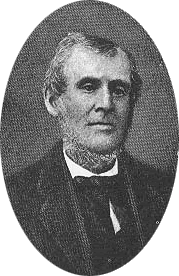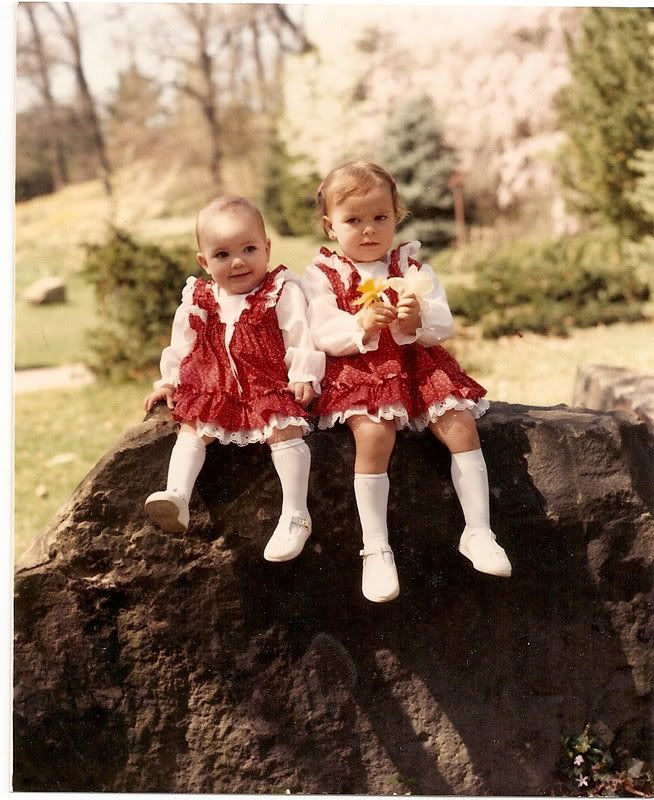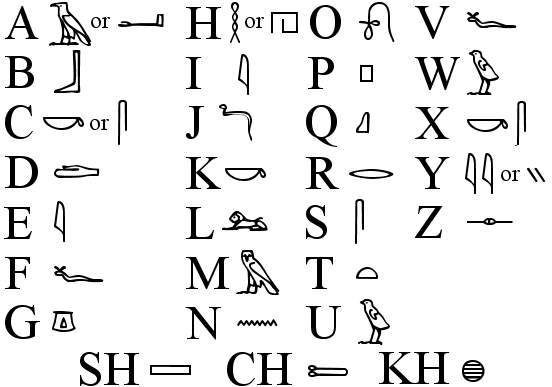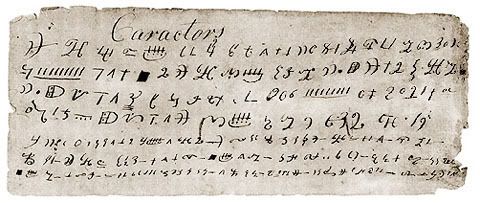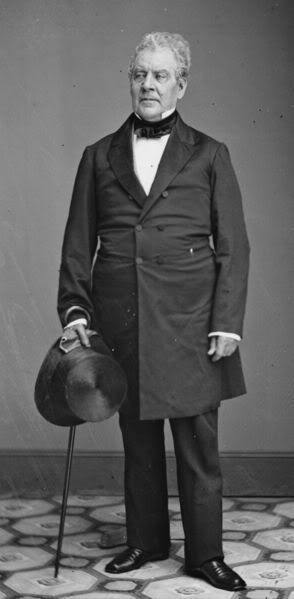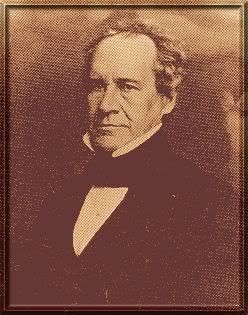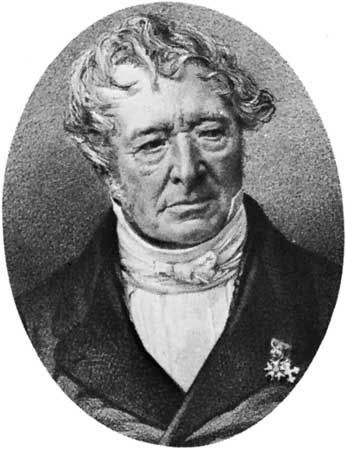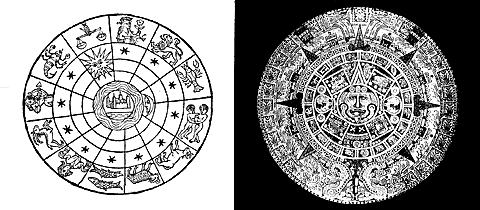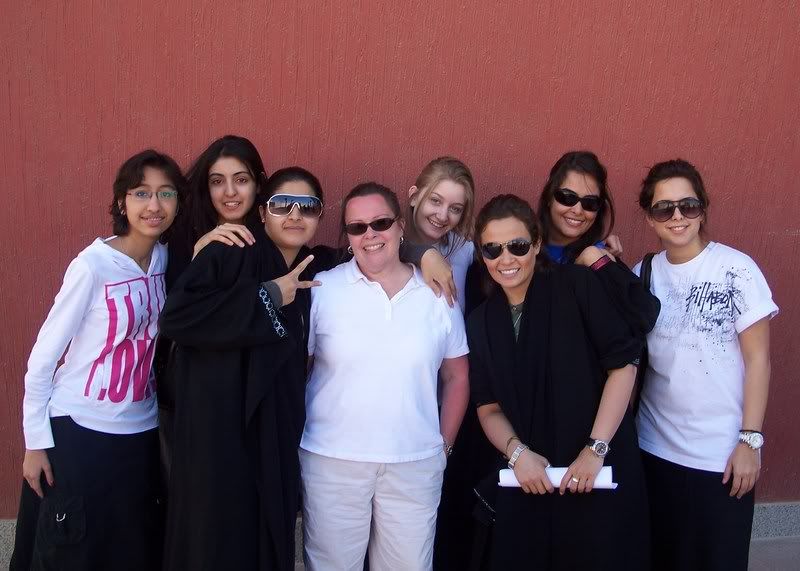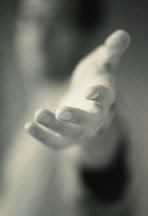Part 4 of a series on Martin Harris and the Anthon TranscriptIt seems like I've taken a long time just to say that Martin Harris was in possession of a copy of some of the characters from the Book of Mormon and that he consulted some of the leading candidates of the day who might have been able to authenticate them. Now the time has come to more fully examine Professor Anthon's account of Martin Harris' visit. Extant are two letters in which Charles Anthon replied to enquiries about his encounter with Harris. I will reproduce them in their entirety and then discuss what they reveal about Mormon history and scholarship.
1. This letter was written to Eber D. Howe, Editor of the Painesville Telegraph (1822–1835), author, and publisher of Mormonism Unvailed. On February 9, 1834 Howe wrote to Charles Anthon about Mormon claims that he had authenticated Book of Mormon characters. Anthon answered in a response dated Feb. 17, 1834:
New York, Feb. 17, 1834
Dear Sir -
I received this morning your favor of the 9th instant, and lose no time in making a reply. The whole story about my having pronounced the Mormonite inscription to be "reformed Egyptian hieroglyphics" is perfectly false. Some years ago, a plain, and apparently simple-hearted farmer, called upon me with a note from Dr. Mitchell of our city, now deceased, requesting me to decypher, if possible, a paper, which the farmer would hand me, and which Dr. M. confessed he had been unable to understand. Upon examining the paper in question, I soon came to the conclusion that it was all a trick, perhaps a hoax. When I asked the person, who brought it, how he obtained the writing, he gave me, as far as I can now recollect, the following account: A "gold book," consisting of a number of plates of gold, fastened together in the shape of a book by wires of the same metal, had been dug up in the northern part of the state of New York, and along with the book an enormous pair of "gold spectacles"! These spectacles were so large, that, if a person attempted to look through them, his two eyes would have to be turned towards one of the glasses merely, the spectacles in question being altogether too large for the breadth of the human face. Whoever examined the plates through the spectacles, was enabled not only to read them, but fully to understand their meaning. All this knowledge, however, was confined at that time to a young man, who had the trunk containing the book and spectacles in his sole possession. This young man was placed behind a curtain, in the garret of a farm house, and, being thus concealed from view, put on the spectacles occasionally, or rather, looked through one of the glasses, decyphered the characters in the book, and, having committed some of them to paper, handed copies from behind the curtain, to those who stood on the outside. Not a word, however, was said about the plates having been decyphered "by the gift of God." Every thing, in this way, was effected by the large pair of spectacles. The farmer added, that he had been requested to contribute a sum of money towards the publication of the "golden book," the contents of which would, as he had been assured, produce an entire change in the world and save it from ruin. So urgent had been these solicitations, that he intended selling his farm and handing over the amount received to those who wished to publish the plates. As a last precautionary step, however, he had resolved to come to New York, and obtain the opinion of the learned about the meaning of the paper which he brought with him, and which had been given him as a part of the contents of the book, although no translation had been furnished at the time by the young man with the spectacles. On hearing this odd story, I changed my opinion about the paper, and, instead of viewing it any longer as a hoax upon the learned, I began to regard it as part of a scheme to cheat the farmer of his money, and I communicated my suspicions to him, warning him to beware of rogues. He requested an opinion from me in writing, which of course I declined giving, and he then took his leave carrying the paper with him. This paper was in fact a singular scrawl. It consisted of all kinds of crooked characters disposed in columns, and had evidently been prepared by some person who had before him at the time a book containing various alphabets. Greek and Hebrew letters, crosses and flourishes, Roman letters inverted or placed sideways, were arranged in perpendicular columns, and the whole ended in a rude delineation of a circle divided into various compartments, decked with various strange marks, and evidently copied after the Mexican Calender given by Humboldt, but copied in such a way as not to betray the source whence it was derived. I am thus particular as to the contents of the paper, inasmuch as I have frequently conversed with my friends on the subject, since the Mormonite excitement began, and well remember that the paper contained any thing else but "Egyptian Hieroglyphics." Some time after, the same farmer paid me a second visit. He brought with him the golden book in print, and offered it to me for sale. I declined purchasing. He then asked permission to leave the book with me for examination. I declined receiving it, although his manner was strangely urgent. I adverted once more to the roguery which had been in my opinion practised upon him, and asked him what had become of the gold plates. He informed me that they were in a trunk with the large pair of spectacles. I advised him to go to a magistrate and have the trunk examined. He said the "curse of God" would come upon him should he do this. On my pressing him, however, to pursue the course which I had recommended, he told me that he would open the trunk, if I would take the "curse of God" upon myself. I replied that I would do so with the greatest willingness, and would incur every risk of that nature, provided I could only extricate him from the grasp of rogues. He then left me.
I have thus given you a full statement of all that I know respecting the origin of Mormonism, and must beg you, as a personal favor, to publish this letter immediately, should you find my name mentioned again by these wretched fanatics.
Yours respectfully, CHAS. ANTHON.
2. The second letter was in response to a letter from Reverend Dr. Thomas Winthrop Coit who was Rector of Trinity Church in New Rochelle, New York from 1839-1849. Having heard the Mormon claim that Anthon had actually validated Joseph Smith's "translation" of the Book of Mormon but had torn up the alleged affidavit before Harris could leave with it, Rev. Coit wrote to Anthon requesting a statement from him about his involvement in the affair. Anthon responded on April 3, 1841 with the following:
New York, April 3d, 1841.
Rev. and Dear Sir:
I have often heard that the Mormons claimed me for an auxiliary, but, as no one, until the present time, has ever requested from me a statement in writing, I have not deemed it worth while to say anything publicly on the subject. What I do know of the sect relates to some of the early movements; and as the facts may amuse you, while they will furnish a satisfactory answer to the charge of my being a Mormon proselyte, I proceed to lay them before you in detail.
Many years ago, the precise date I do not now recollect, a plain looking countryman called upon me with a letter from Dr. Samuel L. Mitchell requesting me to examine, and give my opinion upon, a certain paper, marked with various characters, which the Doctor confessed he could not decypher, and which the bearer of the note was very anxious to have explained. A very brief examination of the paper convinced me that it was a mere hoax, and a very clumsy one too. The characters were arranged in columns, like the Chinese mode of writing, and presented the most singular medley that I ever beheld. Greek, Hebrew and all sorts of letters, more or less distorted, either through unskilfulness or from actual design, were intermingled with sundry delineations of half moons, stars, and other natural objects, and the whole ended in a rude representation of the Mexican zodiac. The conclusion was irresistible, that some cunning fellow had prepared the paper in question for the purpose of imposing upon the countryman who brought it, and I told the man so without any hesitation. He then proceeded to give me the history of the whole affair, which convinced me that he had fallen into the hands of some sharper, while it left me in great astonishment at his simplicity.
The countryman told me that a gold book had been recently dug up in the western or northern part (I forget which), of our state, and he described this book as consisting of many gold plates, like leaves, secured by a gold wire passing through the edges of each, just as the leaves of a book are sewed together, and presented in this way the appearance of a volume. Each plate, according to him, was inscribed with unknown characters, and the paper which he handed me, a transcript of one of these pages. On my asking him by whom the copy was made, he gravely stated, that along with the golden book there had been dug up a very large pair of spectacles! so large in fact that if a man were to hold them in front of his face, his two eyes would merely look through one of the glasses, and the remaining part of the spectacles would project a considerable distance sideways! These spectacles possessed, it seems a very valuable property, of enabling any one who looked through them, (or rather through one of the lenses,) not only to decypher the characters on the plates, but also to comprehend their exact meaning, and be able to translate them!! My informant assured me that this curious property of the spectacles had been actually tested, and found to be true. A young man, it seems, had been placed in the garret of a farm-house, with a curtain before him, and having fastened the spectacles to his head, had read several pages in the golden book, and communicated their contents in writing to certain persons stationed on the outside of the curtain. He had also copied off one page of the book in the original character, which he had in like manner handed over to those who were separated from him by the curtain, and this copy was the paper which the countryman had brought with him. As the golden book was said to contain very great truths, and most important revelations of a religious nature, a strong desire had been expressed by several persons in the countryman's neighbourhood, to have the whole work translated and published. A proposition had accordingly been made to my informant, to sell his farm, and apply the proceeds to the printing of the golden book, and the golden plates were to be left with him as security until he should be reimbursed by the sale of the work. To convince him more clearly that there was no risk whatever in the matter, and that the work was actually what it claimed to be, he was told to take the paper, which purported to be a copy of one of the pages of the book, to the city of New York, and submit it to the learned in that quarter, who would soon dispel all his doubts, and satisfy him as to the perfect safety of the investment. As Dr. Mitchell was our "Magnus Apollo" in those days, the man called first upon him; but the Doctor, evidently suspecting some trick, declined giving any opinion about the matter, and sent the countryman down to the college, to see, in all probability what the "learned pundits" in that place would make of the affair. On my telling the bearer of the paper that an attempt had been made to impose on him and defraud him of his property, he requested me to give him my opinion in writing about the paper which he had shown to me. I did so without hesitation, partly for the man's sake, and partly to let the individual "behind the curtain" see that his trick was discovered. The import of what I wrote was, as far as I can now recollect, simply this, that the marks in the paper appeared to be merely an imitation of various alphabetical characters, and had, in my opinion, no meaning at all connected with them. The countryman then took his leave, with many thanks, and with the express declaration that he would in no shape part with his farm, or embark in the speculation of printing the golden book.
The matter rested here for a considerable time, until one day, when I had ceased entirely to think of the countryman and his paper, this same individual, to my great surprise, paid me a second visit. He now brought with him a duodecimo volume, which he said was a translation into English of the "Golden Bible." He also stated, that notwithstanding his original determination not to sell his farm, he had been induced evidently to do so, and apply the money to the publication of the book, and had received the golden plates as a security for payment. He begged my acceptance of the volume, assuring me that it would be found extremely interesting, and that it was already "making great noise" in the upper part of the state. Suspecting now that some serious trick was on foot, and that my plain looking visitor might be in fact a very cunning fellow I declined his present, and merely contented myself with a slight examination of the volume while he stood by. The more I declined receiving it, however, the more urgent the man became in offering the book, until at last I told him plainly, that if he left the volume, as he said he intended to do, I should most assuredly throw it after him as he departed. I then asked him how he could be so foolish as to sell his farm and engage in this affair; and requested him to tell me if the plates were really of gold. In answer to this latter inquiry, he said, that he had never seen the plates themselves, which were carefully locked up in a trunk, but that he had the trunk in his possession. I advised him by all means to open the trunk and examine its contents, and if the plates proved to be of gold, which I did not believe at all, to sell them immediately. His reply was, that. if he opened the trunk, the "curse of heaven would descend upon him and his children.' "However," added he, "I will agree to open it, provided you take the 'curse of Heaven' upon yourself, for having advised me to the step." I told him I was perfectly willing to do so, and begged he would hasten home and examine the trunk, for he would find that he had been cheated. He promised to do as I recommended, and left me, taking his book with him. I have never seen him since.
Such is a plain statement of all I know respecting the Mormons. My impression now is, that the plain looking countryman was none other than the prophet Smith himself, who assumed an appearance of great simplicity in order to entrap me, if possible, into some recommendation of his book. That the prophet aided me by his inspiration, in interpreting the volume, is only one of the many amusing falsehoods which the Mormonites utter relative to my participation in their doctrines. Of these doctrines I know nothing whatever, nor have I ever heard a single discourse from any of their preachers, although I have often felt a strong curiosity to become an auditor, since my friends tell me that they frequently name me in their sermons, and even go so far as to say that I am alluded to in the prophecies of Scripture!
If what I have here written shall prove of any service in opening the eyes of some of their deluded followers to the real designs of those who profess to be the apostles of Mormonism, it will afford me satisfaction equalled, I have no doubt, only by that which you yourself will feel on this subject.
I remain, very respectfully and truly, your friend,
CHAS. ANTHON.
These two letters are rich with information about early Church history. The tidbit which fascinates me the most is Anthon's description of the translation process, as explained to him by Martin Harris. It adds more to our understanding of how Joseph Smith's contemporaries perceived the translating was done. W.W. Phelps explained that the translation was done "through the aid of a pair of Interpreters, or spectacles — (known perhaps, in ancient days as Teraphim, or Urim and Thummim) ..." [1] Some have disagreed with Phelps' speculation and supposed that the "Urim and Thummim" referred to the Seer Stone that Joseph later used in the translation process. [2] But Anthon's letter makes it clear that in 1828 Harris was describing the means of translating the Book of Mormon as a large pair of spectacles. David Whitmer explained that the "Interpreters" (spectacles) were taken from Joseph as a punishment after he and Martin Harris lost the 116 pages of manuscript of the Book of Mormon. Later Joseph was allowed to recommence the translation using a Seer stone. [3] Accounts of the translation done with the use of the Seer stone abound. Isaac Hale explained that the translation was done by use of the Seer Stone without the physical presence of the plates. Joseph placed his seer stone in a hat and the translation would appear. [4] Emma Smith's description of the process agrees with her father's, saying that Joseph translated with his face buried in a hat. [5] David Whitmer's account adds detail to this idea, explaining how the characters appeared one at a time. [6]
Anthon's letters thus help to clarify how the translation of the Book of Mormon was done. The 116 manuscript pages were translated using a large pair of spectacles. The portion of the plates which comprises our Book of Mormon was translated by the use of a Seer Stone. Since the various accounts call both the spectacles and the Seer Stone(s) by the words "Interpreters" and "Urim and Thummim," [7] I would speculate that these two terms might loosely be used to refer to any divine instrument of translation.
I will leave you now with this one interesting example of how the Anthon letters contribute to our understanding of Mormonism. Perhaps my readers may wish to add comments with other insights from the above letters.
To be continued....
____________________________________________________
[1] W.W. Phelps, Evening and Morning Star, vol. 1, no. 8, (Independence, Missouri, January 1833) p. 2.
[2] This confusion has resulted from the accounts of some of the early Saints which concatenate the Urim and Thummim, the Interpreters, and the seer stone. For example, Oliver Cowdery, who joined in the translation effort in the winter of 1828 exults: "These were days never to be forgotten — to sit under the sound of a voice dictated by the inspiration of heaven, awakened the utmost gratitude of this bosom! Day after day I continued, uninterrupted, to write from his mouth, as he translated, with the Urim and Thummim, or, as the Nephites would have said, 'Interpreters,' the history, or record, called 'The book of Mormon." (Oliver Cowdery, Messenger and Advocate, (Kirtland, Ohio, 1834), vol. 1, no. 1, p.14.)
[3] In an 1885 interview, Zenas H. Gurley, then the editor of the RLDS Saints’ Herald, asked David Whitmer if Joseph had used his "Peep stone" to do the translation. Whitmer replied: "... he used a stone called a 'Seers stone,' the 'Interpreters' having been taken away from him because of transgression. The 'Interpreters' were taken from Joseph after he allowed Martin Harris to carry away the 116 pages of Ms [manuscript] of the Book of Mormon as a punishment, but he was allowed to go on and translate by use of a 'Seers stone' which he had, and which he placed in a hat into which he buried his face, stating to me and others that the original character appeared upon parchment and under it the translation in English." (Elder Z.H. Gurley holograph in LDS Church archives, cited by Richard S. Van Wagoner in "Joseph Smith: The Gift of Seeing," Dialogue: A Journal of Mormon Thought, 15:2 (Summer 1982), p. 54.)
[4] ""The manner in which he pretended to read and interpret, was the same as when he looked for the money-diggers, with a stone in his hat, and his hat over his face, while the Book of Plates were at the same time hid in the woods." (Affidavit of Isaac Hale dated March 20, 1834, cited in Rodger I. Anderson, Joseph Smith’s New York Reputation Reexamined, (Salt Lake City: Signature Books, 1990), pp. 126-128.)
[5] "In writing for your father I frequently wrote day after day, often sitting at the table close by him, he sitting with his face buried in his hat, with the stone in it, and dictating hour after hour with nothing between us." (History of the RLDS Church, 8 vols., Independence, Missouri: Herald House, 1951, "Last Testimony of Sister Emma," 3:356.)
[6] "Joseph Smith would put the seer stone into a hat, and put his face in the hat, drawing it closely around his face to exclude the light; and in the darkness the spiritual light would shine. A piece of something resembling parchment would appear, and on that appeared the writing. One character at a time would appear, and under it was the interpretation in English. Brother Joseph would read off the English to Oliver Cowdery, who was his principal scribe, and when it was written down and repeated to Brother Joseph to see if it was correct, then it would disappear, and another character with the interpretation would appear." (David Whitmer, An Address to All Believers in Christ, Richmond, Missouri: n.p., 1887, p. 12.)
[7] In 1823 Joseph Smith equated the Urim and Thummim with the spectacles: "...there were two stones in silver bows—and these stones, fastened to a breastplate, constituted what is called the Urim and Thummim--deposited with the plates; and the possession and use of these stones were what constituted “seers” in ancient or former times; and that God had prepared them for the purpose of translating the book." (JS-H 1:35) By 1835 the term "Urim and Thummim" was added to the revelation published as D&C 10 (verse 1), and thereafter, was used to refer to both the Nephite interpreters and the seer stone(s) by Joseph Smith and numerous other people. Joseph Knight, Sr., an early member of the Church and a close friend of Joseph Smith, equates the Urim and Thummim with the Seer stone: "Now the way he translated was he put the urim and thummim into his hat and darkened his eyes then he would take a sentance and it would appear in brite roman letters then he would tell the writer and he would write it then that would go away the next sentence would come and so on. But if it was not spelt rite it would not go away till it was rite, so we see it was marvelous. Thus was the hol [whole] translated." (Cited in Dean Jessee, "Joseph Knight's Recollection of Early Mormon History," BYU Studies, vol. 17:1 (Autumn 1976), p. 35.)
Labels: Anthon transcript, Book of Mormon, Joseph Smith, Mormon history, scripture, Sunday School
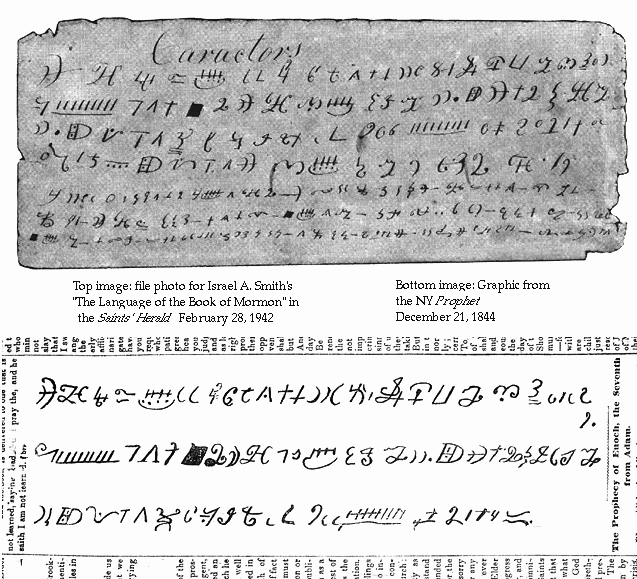
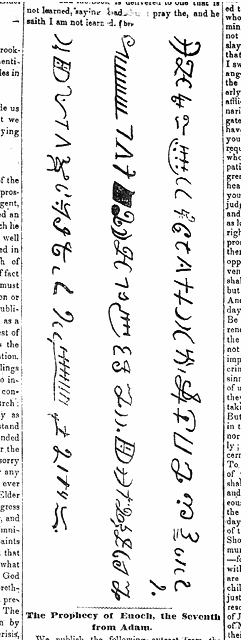 This discovery explains some things, and brings up more questions. First, Anthon's letter describes the characters as "crooked." He says that "Greek and Hebrew letters, crosses and flourishes, Roman letters inverted or placed sideways, were arranged in perpendicular columns." For example, we see letters similar to the Roman "H," "T," "V," "C," and "U," and if they were viewed in columns, they would appear to be "placed sideways." But the question might be raised: was the slip of paper we know as the "Caractors Document" written in columns, with the label "Caractors" written as an afterthought? Or had Martin Harris and Charles Anthon looking at the document turned the wrong way? Since Joseph was not there to instruct them, this is a possibility.
This discovery explains some things, and brings up more questions. First, Anthon's letter describes the characters as "crooked." He says that "Greek and Hebrew letters, crosses and flourishes, Roman letters inverted or placed sideways, were arranged in perpendicular columns." For example, we see letters similar to the Roman "H," "T," "V," "C," and "U," and if they were viewed in columns, they would appear to be "placed sideways." But the question might be raised: was the slip of paper we know as the "Caractors Document" written in columns, with the label "Caractors" written as an afterthought? Or had Martin Harris and Charles Anthon looking at the document turned the wrong way? Since Joseph was not there to instruct them, this is a possibility. Well, dear readers, I leave you with my impressions that the characters with which we are by now familiar were those viewed by Charles Anthon in 1828. Over the years, these characters have become well-known to members of the Church. In 1980 the Church came out with a gold-cover edition of the Book of Mormon which had the letters from the Caractors Document inscribed in black lettering. I had one in my possession until this last move. :( These characters and the story of the Anthon transcript fascinate us because, since we do not have the gold plates to handle and touch, they represent the most concrete and tangible evidence we have. Of course, a testimony of the Book of Mormon will never depend on evidence, but our mortal minds do appreciate what little there is.
Well, dear readers, I leave you with my impressions that the characters with which we are by now familiar were those viewed by Charles Anthon in 1828. Over the years, these characters have become well-known to members of the Church. In 1980 the Church came out with a gold-cover edition of the Book of Mormon which had the letters from the Caractors Document inscribed in black lettering. I had one in my possession until this last move. :( These characters and the story of the Anthon transcript fascinate us because, since we do not have the gold plates to handle and touch, they represent the most concrete and tangible evidence we have. Of course, a testimony of the Book of Mormon will never depend on evidence, but our mortal minds do appreciate what little there is.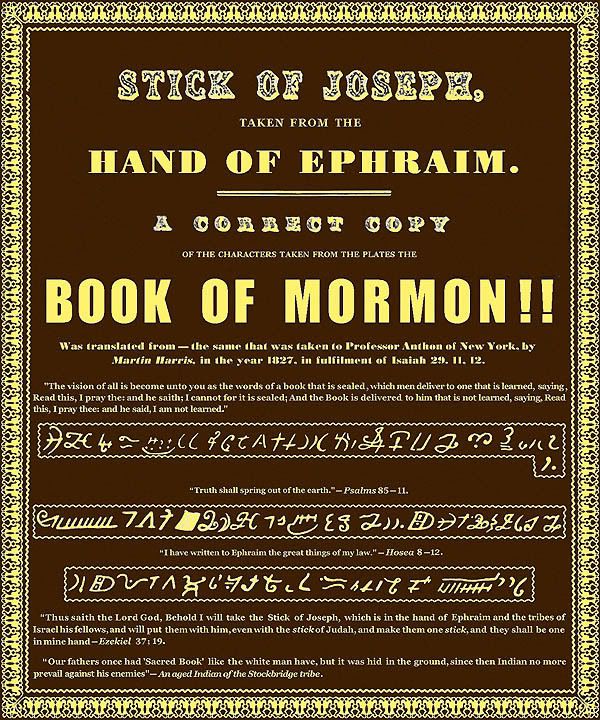 [3] BYU Studies, vol.20, no.4, p.325. Twice in late 1844, after the Prophet's martyrdom, portions of these symbols were published as characters that Joseph Smith had copied from the gold plates. Characters appeared in the December 21 issue of the Mormon newspaper The Prophet. Also, (right, click to enlarge) in 1844 the Latter-day Saints published a broadside with the title "Stick of Joseph" which contained these same characters copied from the plates.
[3] BYU Studies, vol.20, no.4, p.325. Twice in late 1844, after the Prophet's martyrdom, portions of these symbols were published as characters that Joseph Smith had copied from the gold plates. Characters appeared in the December 21 issue of the Mormon newspaper The Prophet. Also, (right, click to enlarge) in 1844 the Latter-day Saints published a broadside with the title "Stick of Joseph" which contained these same characters copied from the plates. 